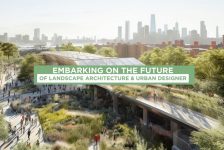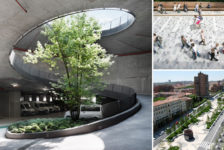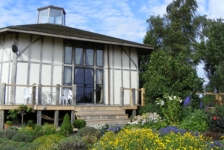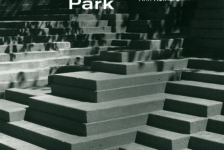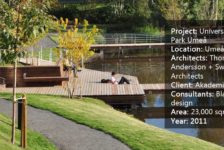Article by Ophelia Yuting – Take a break with us and enjoy these 10 carefully selected YouTube videos which show the landscape in a whole new light. As landscape architects, we get used to being exposed to two-dimensional inspirations — photos, drawings, or artwork on flat platforms. But the 2D perception has its limitations. We live in a three-dimensional, multifaceted world, and we need to be able to explore landscape design in terms of sound, motion, feelings, and atmosphere. All of these can be perfectly captured in a video. Here, we offer 10 awesome YouTube videos you must not miss.
1. Allgood Trio Sesame Stairs
Instead of constructing an ADA ramp to take over extra space at the front door, Allgood chose an innovative way of designing so-called “Sesame Steps” to help people in wheelchairs access buildings conveniently and efficiently. Most of the time, these Sesame Steps look like regular staircases. But when people who use wheelchairs reach the steps, they can simply press a button and the Sesame Steps immediately transform into a moving platform that can take them from street to entrance level in one minute. In this way, not only is the construction space of long ramps saved, but people also can save the energy they would have expended to move up the ramps with their wheelchairs. The whole process is fully automatic and easy to operate. Based in the United Kingdom, Allgood is a firm specializing in providing systematic solutions of mechanical and electrical items, as well as door furniture, aiming to improve convenience and security through their considerate designs. WATCH >>> Sesame stairs from Allgood Trio Alt soundtrack
2. Dutch Cycle-Friendly Junction Design
Differing from a standard American cycle lane — which usually has bad crossing angles — a Dutch cycle lane keeps cyclists to the right side of traffic and opens up the curb to let cyclists go straight on. Additionally, an extra curb with the same radius as the existing one is added to connect cycle lanes on both streets, which also provides room for a protective traffic island, improving safety tremendously. In this way, when bike riders wait to cross at the junction, they will be in very clear view of right-turning drivers. Most likely, a cyclist will be gone once the car arrives at the crossing place. But if they do meet, eye contact is possible, because both can look to the front, as we can see in this video by BicycleDutch (below). WATCH >>> Junction design the Dutch – cycle friendly – way
3. Waterfall Swing — World Maker Faire
Have you ever imagined sitting on a swing while enjoying the beauty of a waterfall? The interactive art swing design by Mike O’Toole, Andrew Ratcliff, Ian Charnas, and Andrew Witte — built by Dash 7 Design — has made this joyfully possible. This towering steel swing set holds arrays of mechanical solenoids that create a water plane falling into the path of its riders. Axel-housed encoders accurately monitor the timing of when the water falls to avoid the possibility of drenching the riders and also provide an exciting experience of escaping under the manmade waterfall Check out more information about this Waterfall Swing at waterfallswing.com and their exciting video WATCH >>> Waterfall Swing – World Maker Faire
4. The World’s Deepest Trash Bin
Can we get more people to throw their rubbish in the bin by making it fun to do so? The answer is yes. By installing a sensor in a trash bin to simulate the sound of objects falling into a deep well, thefuntheory.com has made this happen successfully. During the experimental day, 72 kg of rubbish was collected in this special bin — 41 kg more than the normal bin just a small distance away “Fun can obviously change behavior for the better,” The funtheory team says in its video. This small fun act definitely encourages people to throw their rubbish into a trash bin in a positive and humorous way, inspiring us landscape architects to do other small things that make a big difference. WATCH >>> The World’s Deepest Trash Bin (Fun Theory)
5. Theo Jansen’s Strandbeests
Since 1990, the kinetic sculptor and artist Theo Jansen has been working on a project to create new forms of “life” by using yellow plastic tubes. After many years of experiments, he has successfully created these skeletons that walk smoothly on the wind without anyone’s help or other energy sources. These “beach animals” are strong enough to tolerate storms and will be able to “live their own lives” on the beach in Holland, Jansen says. Having studied applied physics at Delft University of Technology and later leaving his studies to become an artist, Jansen is good at combining science, art, sculpture, and motion, producing such an amazing “living” creature with manmade materials. Check out his website to see more information about this project and the documentary video “Theo Jansen’s Strandbeests – Wallace & Gromit’s World of Invention Episode 1 Preview” by BBC here: WATCH >>> Theo Jansen’s Strandbeests – Wallace & Gromit’s World of Invention Episode 1 Preview – BBC One
6. Eddie George on Careers in Landscape Architecture
Landscape architects are often misidentified as people who simply cut grass and put soil down in the garden. But they are actually designers who create amazing outside spaces, says Eddie George. George, perhaps more famous as an Ohio State University football star, fell in love with landscape architecture during his studies. But he always has trouble explaining this career to his teammates and others. “Landscape architecture is a cool career. It’s time for young people to understand this career needs more creative thinkers and more talents, to help the profession to expand beyond what we are today,” George says in his video: WATCH >>> Eddie George on Careers in Landscape Architecture
7. 3-Sweep: Extracting Editable Objects from a Single Photo, SIGGRAPH ASIA 2013
By introducing an interactive technique for modeling three-dimensional manmade objects, the new product called “3-Sweep” has tremendously changed the way we think about 3D modeling. Different from traditional 3D modeling in which users need to model line by line and shape by shape, this new method simply extracts objects from a single photograph. This research was conducted by Tao Chen, Zhe Zhu, Ariel Shamir, Shi-Min Hu, and Daniel Cohen-Or and presented in Siggraph Asia in 2013. As their video says, “the method intelligently combines the cognitive ability of human with the computational accuracy of a machine.” From its name we can see that each model only needs “three sweeps” to complete. The first two strokes define the profile of the object and the third one sweeps it along its main axis. Once the 3-sweep is done, a 3D model based on the photograph will automatically be created and be ready for users to further edit. Various textures and parametric attributes can be given to the objects. WATCH >>> 3-Sweep: Extracting Editable Objects from a Single Photo, SIGGRAPH ASIA 2013
8. Bike Lanes by Casey Neistat
Casey Neistat got a $50 fine for not riding in a bike lane in New York City back in 2011, but he argued that there are constructions everywhere that block the bike lanes and make it impossible for riders to stay in them. Instead of ticketing riders, New York City needs to consider how to remove these obstacles in the bike lanes and create a cozy and easy environment for people who want to exercise, enjoy a little leisure, or commute by their bicycles. This also gives inspiration for landscape architects, as we always need to consider users’ experiences and understand why they spontaneously choose another way to use our spaces than the way we designed. We need to try to adjust future designs to serve them better. WATCH >>> Bike Lanes by Casey Neistat
9. What is Geocaching?
Geocaching is a way to “cache” information based on geographic locations. Different from the traditional concept of “caching” in the virtual world, geocaching is actually something you can touch and feel in reality. Two million geocaches worldwide will take you on adventures that you never expected and give you surprises — knick-knacks hidden in the geocaching boxes. These boxes come in different sizes and shapes and might require some efforts to find. You simply need to register a personal account at geocaching.com, then start your adventures by using your GPS or smartphone to track these geocaching locations. Once you find the geocaching boxes, you can trade some small gifts for the next one, write down your name on the logbook, and log your finding online. The “geocaching” was first created by Matt Stum on the “GPS Stash Hunt” mailing list in 2000. It was later seen by Jeremy Irish, a web developer for a Seattle company who was interested in doing adventurous activities. Irish then started a hobby site for the activity, called Geocaching.com, to let more people join in the cache-hunting experience. So what are you waiting for? WATCH >>> What is Geocaching?
10. Iguazu Falls
Whether you are a landscape architect or a tourist interested in natural views, you must not miss the spectacular natural scenery of Iguazu Falls. These waterfalls are located where Argentina, Brazil, and Paraguay meet. Besides enjoying the beauty of these waterfalls, you can also get a marvelous view at the tri-border point of these three countries. Eighty percent of these waterfalls are in Argentina and 20 percent are in Brazil. Each side has its own unique landscape and waterscape to admire. You can walk on the winding observation platforms, hike the trails in the forests, enjoy the beauty of a rainbow in the waterfalls, observe diverse animals such as coati and toucan, and take a boat to be as close as possible to the waterfalls. The park offers adventure as well as inspiration for landscaping design ideas about how to build a close relationship between humans and nature. After all, the greatest landscape architect in the world is nature. WATCH >>> Iguazu Falls Vacation Travel Guide | Expedia
Now that you have enjoyed these wonderful videos, either from professional artists and designers or people who are enthusiastic about our environment, you will realize that small ideas can make a big difference. All we have to do is to start taking action. So, do you have interesting findings of your surroundings that you want to share with others? Are you ready to let your ideas go viral and make an impact on our society, just like these people did?
Recommended Reading:
- Becoming an Urban Planner: A Guide to Careers in Planning and Urban Design by Michael Bayer
- Sustainable Urbanism: Urban Design With Nature by Douglas Farrs
- eBooks by Landscape Architects Network
Article by Ophelia Yuting
Published in Blog



